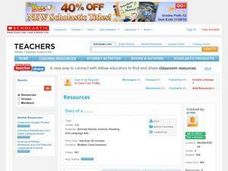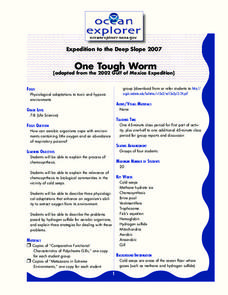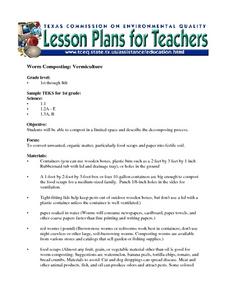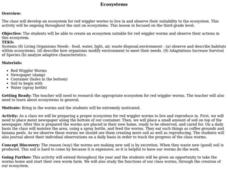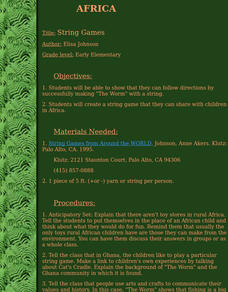Curated OER
Dirt Cups
After a hard day examining and dissecting worms, why not put your feet up and snack on a few? Here is a really cute idea that can be used to celebrate Earth Day or to accent a thematic learning experience. Kids use clay pots, gummy...
Curated OER
F.B.I.
Students create a worm bin full of fruit and vegetable scraps wit paper and observe what happens over time. In this decomposers lesson plan, students observe that the fruit and vegetable scraps become new soil.
Curated OER
Animal Diary
Young scholars create a diary of an animal. In this creative writing lesson, students read the book Diary of a Worm and conduct a brief research session on their animal. Young scholars fill in a template with facts and create an animal...
Curated OER
Convening, Creating, and Conventioneering
Students study coelenterates. In this science lesson, students author a story regarding the life cycle of coelenterates following an in depth study of the creatures.
Curated OER
More Bait for Your Buck!
Students determine where to buy the heaviest earthworms as they study invertebrates. They create a double bar graph of the results of the weight data.
Curated OER
One Tough Worm
Students explain the process of chemosynthesis and its relevance to biological communities. In this investigative activity students discuss chemosynthetic communities, then in groups they are assigned a species and are to calculate the...
Curated OER
Worm Composting: Vermiculture
Students set up their own composting bin. They observe and record their findings during a period of time. They describe the decomposing process as well.
Curated OER
Toothpick Worms
Students investigate camouflage. In this science lesson plan, students experience the role of color in camouflage as they complete a hands-on activity.
Curated OER
Worms And More
Students complete five center activities that in order to determine the attributes of length and area. They study the vocabulary associated with measurement of length and area. They use blocks, play dough, wrapping paper, and footprints...
Curated OER
W is for Worm: The Letter W
For this letter w worksheet, students practice tracing, then printing the upper and lower case letter w. Students can move a computer mouse over sample letters with guided arrows to begin.
Curated OER
Matching Sets of Objects: Birds and Worms
For this matching sets worksheet, students count the animals in each of 3 sets on one side of the page. Students draw lines to match them with sets on the opposite side that have the same number of animals in them.
Curated OER
Worming Your Way Through the Soil
Students study soil, living and non-living particles in the soil, and learn about composting. In this soil study lesson, students study soil samples and discuss the living and non-living components of the soil. Students classify the...
Curated OER
Primary Source Analysis: 95 Theses Excerpts
By reviewing and analyzing these nine selected points from Martin Luther's 95 Theses, your young historians will discern the major tenets of the revolutionary challenge made against the Catholic Church in the seventeenth century. This is...
Curated OER
Animal Life Stages
Guide your young scientists in reviewing basic animal processes including digestion and reproduction. Students review the stages of metamorphosis and the different types of body symmetry. This worksheet has 8 matching, 6 true or false, 4...
Curated OER
Tongue Twisters
Young readers practice their letter sounds by engaging with this language arts PowerPoint. Six letters are used: p, l, s, w, c, and d. Pupils learn tongue twisters for each letter such as: "Wiggly worm wiggles in the water." Very nice!
Planet e-Book
Oliver Twist
"Please, sir. May I have some more?" An eBook version of Oliver Twist by Charles Dickens introduces readers to the text that inspired the classic line. An oldie but a goodie, book worms see why this novel is so beloved.
Curated OER
Chapter 1: The Science of Biology
Provide young biologists with everything they need to excel in the study of lymphatics, the nervous system, hormones, cellular division, and more! Pupils utilize the workbook, complete with end-of-chapter assessment worksheets, to...
Curated OER
Ecosystems
Third graders create an ecosystem for red wiggler worms to observe as they work on a complete unit.
Curated OER
Questions 10: Chapters XXVII-XXIX: Pages 56-95
In this reading comprehension worksheet, students answer 12 short essay questions that pertain to chapters 27-29. The name of the book is not specified, but it appears to be How to Eat Fried Worms by Thomas Rockwell.
Curated OER
How Does Speed Change?
In this speed learning exercise, learners use a graph that shows various speeds to answer 13 questions. For example. "What is the greatest speed the worm reaches?"
Curated OER
Measuring Inches
First graders measure the length of pipe cleaners to form worms using rulers to focus on inches. They record their results and graph the measurement of each pipe cleaner. They measure their pipe cleaner "worms" in various colors and...
Curated OER
String Games
Fourth graders show that they can follow directions by successfully making "The Worm" with a string. They reate a string game that they can share with students in Africa.
Curated OER
Human Genetics
For this science worksheet, students read about how many genes are present in tomatoes, fruit flies, humans, worms, and honey bees.
Other popular searches
- Diary of a Worm
- Worm Rhyme
- Meal Worms
- Gummy Worms
- Earth Worms
- Inch Worms
- Worm Composting
- Segmented Worms
- Measurement Grade 3 Worms
- How to Eat Fried Worms
- Wonderful Worms
- Tube Worms


